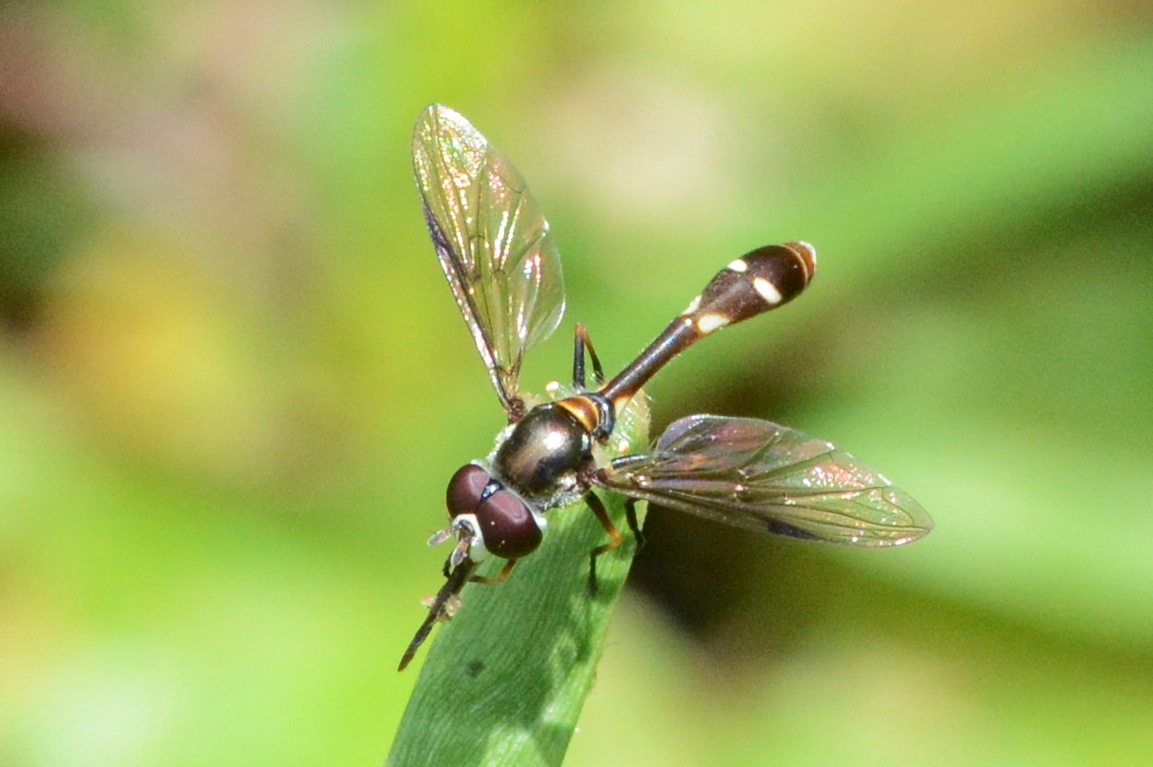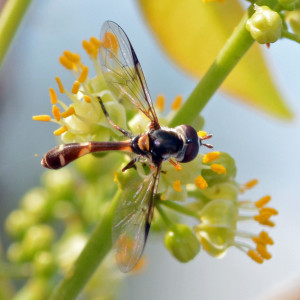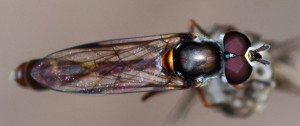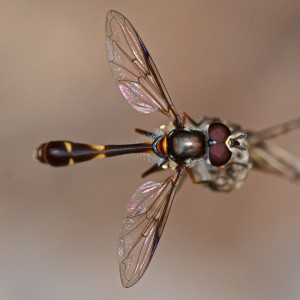The sun came out one day in May of 2013, and I decided to take advantage of the situation and see what I could find in the back yard. And I’m glad I did; I found a lovely little flower fly that I’d been trying to get a picture of for years (and now, nearly two full years later, I still don’t have a better photo, so it’s time to go ahead and post this post!

Flower flies, family Syrphidae, are so called because many of them are major pollinators of flowers as adults, and their larvae are important predators of such flower-unfriendly insects as aphids and whiteflies.
The adults of many species are convincing mimics of bees and wasps; the species above is only moderately convincing compared to some of its congeners. It has the thin, petiolate (slender stalk or stem, like a flower) abdomen typical of wasps (and often known as the “wasp waist”), and it has some peculiar dark markings on the leading edge of the wings. These mimic the structures in the wings of yellowjackets and their kin, which typically fold their wings longitudinally when at rest.
Another name for this family of flies is hover flies because, well, they tend hover a lot. Perhaps they’re scouting for good places to lay their eggs, or maybe just a likely flower to provide nectar. They are able to hover so well because, like all dipterans (flies, members of the insect order Diptera), instead of having two pairs of wings like most flying insects (dragonflies, butterflies, bees, etc.), they have one set of wings (the forewings in this order) that they use to fly, and a modified pair (in dipterans these were the hindwings), called halteres, that are used somewhat like gyroscopes: they apparently provide immediate feedback about tiny modifications in flight plane, attitude, pitch, yaw, etc.
This brings up a problem, though: I’m not sure how to conceptualize insect aeronautics.
- Dragonflies and damselflies (order Odonata) are able to hover and zoom around so amazingly because, my goodness, they have two pairs of wings that they can maneuver independently.
- Bees and wasps (order Hymenoptera) are less capable aeronauts because their two pairs of wings are linked together.
- Butterflies and moths (order Lepidoptera) take seemingly random flight paths but they usually get where they want to go. (I suspect their random fluttery flight is probably just organized so chaotically we simply can’t recognize the ordering principle behind it.)
- Flies, though, are perhaps the most aerobatic of insects (hovering, backward flight, flip landings, etc.) and they do it all with just one pair of wings and a set of gyroscopes.
Still, I’m not going to solve this problem in a post about a funny fly I saw in my back yard. So, back to the fly!
Like many insects, this particular species of hover fly doesn’t have a common name. Fabricius called this species Dioprosopa clavata back in 1794, but it has since been revised; the “new” name assigned by Becker in 1903 is Pseudodoros clavatus. Of course, like all taxonomic names, it’s not without controversy; some recent scholarship indicates that the old name actually needs to be reinstated because this monotypic genus was inappropriately split by Becker.
Gerard Pennards writes of this species on bugguide.net:
In the Syrphids of America there are a few genera with such a petiolate and thin abdomen. For example: the genera Ocyptamus, Allograpta, Leucopodella, Baccha, and Pseudodoros. This last genus [has] just one species: Pseudodoros clavatus. Characteristic are the antennae which are quite close together, and the yellow scutellum with the broad transverse black band.
Etymology
The species name, clavatus, might be derived from at least three Latin words, any of which appears appropriate: club-shaped (from L. clava, club), furnished with points or stripes (from L. clavatus, pointed/striped), or like a nail (from L. clavus, nail). The English word clavate means “thickened near the distal end,” and I’m fairly confident that “club-shaped” is the correct derivation, but I haven’t read Fabricius’s original description.
I’m even less sure about the derivation of the genus name, Pseudodoros, although doros is Greek for leather bag, wallet. Thus a pseudodoros might be a false wallet, perhaps referring to some anatomical feature of this fly of which I remain ignorant.
Fabricius’s original genus name, Dioprosopa, is derived from the Greek prefix dia-, two, and the Greek root word prosopa, face.
Update
Here’s a shot from April 2015, just because it’s weird to have a post in 2015 with photos only from 2013:

It’s on some lovely blossoms of the gumbo limbo tree out front. I’m hoping that it’s laying eggs and that its larvae will help me control the scale insects that are trying to keep that tree from achieving its full potential. Go, predators!
And here are a couple more shots from May:


References
Eaton, E, and K. Kaufman. (2007). Kaufman Field Guide to Insects of North America. New York: Houghton Mifflin.
Kassebeer, C. (2000). Zur Gattung Pseudodoros Becker, 1903 (Diptera, Syrpbidae). Dipteron 3:73–92.
Marshall, S. A. (2012). Flies: The Natural History and Diversity of Diptera. Buffalo, NY: Firefly.
